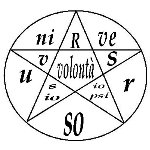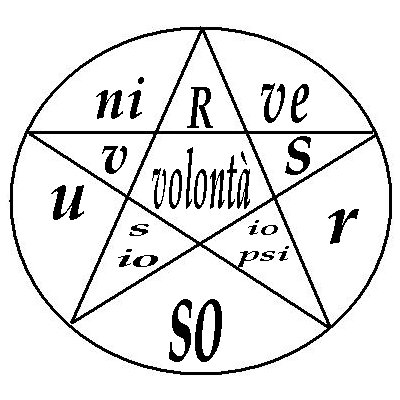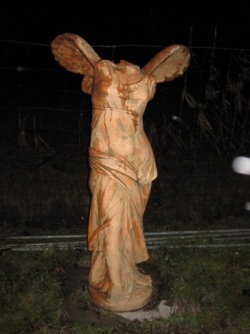Meditation, contemplation, preyer
The elements of the Sorcerer's Crucible: Twelfth part
by Claudio Simeoni
(Italian Pagans' Federation)
Federazione Pagana
Programme broadcast on 10th July 1997
In this programme I will speak again about the Crucible I'm presenting to you from a couple of months. I would like to remind you that the Crucible is something subjective. It's the result of the individual's building of his/her becoming. Nobody can know a priori what kind of influence the contents of the crucible will have on the subjective change of the individual, what kind of adjustments it will bring or what kind of choices it will provoke. The only thing I can know is the importance and the centrality of the Crucible and its elements inside the subjective process of self-building. They're central elements in the building of life. This is the magical becoming of the Human Being. Like every other magical becoming in Polytheistic Paganism and Witchcraft, the magical becoming of the Human Being must be constructed. We must give birth to it.
In other words there's a process of the single Magic Being's formation, which can be expressed by the formula by Reich:
Tension – charge – discharge – relaxation.
The Human Being bears the tensions of its existence, charges them, handles them stirring in its Crucible, discharges them along the line of its needs and predilections and then it can relax because it became master of its own existence.
The foetus needs nine months to be born, the child needs from eight to twelve years to become a man or a woman, the Human Being needs twenty years to construct or to destroy its luminous body. If the Human Being keeps its life on the borderline between growth and destruction without submitting and without fighting for freedom, this process can remain uncertain until the physical body's death (until it's about seventy-eighty years old, in our country)
If a Human Being submitted itself to the god-owner for twenty years and then it discovers it has destroyed itself and wants to retrieve, it needs twenty years looking for Freedom with the same will and determination with which it submitted (or had been submitted). It has to start form the level of submission it reached, and the struggle to escape submission will be very hard and painful, because it will be aware of every effort it will do to rebuild itself.
Missing the path of construction of our Freedom is easy; when we missed it, it's very hard to recover it. This is the reason of one of Witchcraft and Polytheistic Paganism's: never worsen the conditions of our life, never worsen the existing conditions of Freedom. We must act in order to make those conditions wider. Even if our contribute is just a grain of sand and not the great project we would like to do, it will be rewarded when we'll leave our physical body.
Favouring Freedom of the species we belong is contributing to the development of Freedom in the whole surrounding, and doing this will reward us when we'll leave our physical body. It can't rectify our possible destructive actions, but it can take our hand to walk with us: exactly like we did towards the surrounding by our efforts and choices of Freedom!
After this introduction, today we'll put in the Crucible three elements, three behaviours by which we can prepare ourselves to favour the relation between the surrounding world and us, and, at the same time, to face the world.
I'll speak about two elements, and before I speak about the third I'll put a helmet on my head to protect myself from the blows Francesco and other Polytheistic Pagans will strike to me when I'll pronounce it.
The two elements are: meditation and contemplation.
These are practices that prepare us to face the surrounding world.
The basic elements of meditations are breath and the flux of thought words. Central elements of contemplations are our four senses (we exclude the taste because it's strictly bound to the person's physicality), even if in contemplation there's usually one sense that becomes the main sense, while the others have a secondary importance.
The purpose of the meditation is to prepare us in order to face the world. We should sit or lie down in the most comfortable position possible and then breathe, following the breath with our mind, the movements of the diaphragm and the dilatation of lungs until we reach our moment of calmness and continuity in breathing. Then we accord the flux of the thought words with the rhythm of breath. We think to what interests us most, everything. It's important that the flux of words harmonizes itself with the breath, not the contrary.
What can we get by this kind of meditation?
We can escape from the world's upheaval and solicitations. We force our reason to follow a thought in a slow and continue way, to keep constant the interest about the object of our thought. By the breath we interiorise our interest and review all the concerning elements. Meditation shows us how to organize strategically our thought about an object.
In that moment the elements we put inside our Crucible come to us and help our thought: the ambush, the aim, the sceptical attitude… They become part of our thought. They become elements by which we can construct a new expression of thought and they penetrate inside the solar plexus by the slow and regular breath.
After a few months of this practice, if we didn't submit ourselves too much during our existence, we'll start to think in a different way. The thought will have a different strength and a different depth.
This practice can be also considered as a propaedeutic for the suspension of the internal dialogue.
We are the central element of the meditation, while we harmonize the thought with the world's breath; the central element of contemplation is the external object: the contemplated object!
We can contemplate Vegetal Beings, Animal Beings, blades of grass, stones, mountains, the Moon Being or Stars. In the beginning, it's useful to choose the same object every time you want to practise contemplation. A plant you've got home is all right!
I'm speaking about visual contemplation. You can contemplate also sounds, tactile or olfactory sensations. You can contemplate using different senses apart from sight.
The technique consists in sitting or lying down in the most comfortable position to a certain distance from the object (the distance depends on the contemplator). You should look to the object reducing the thought to silence and crossing your eyes until the shape of the object tends to disappear. At the beginning, crossing the eyes, for an adult, can be difficult, but little by little ocular muscles get used to do this; it's just a question of practice. The important is to observe the non-shape, which is observing the contemplated object without pointing the attention on its shape. Contemplation allows us to focus our attention on those things on which our reason never fasten the attention. The reason's attention always discarded those things because they're useless to the description.
We can get some results from this practice:
1) We force reason to consider some aspects it always ignored;
2) We force our sensors (eyes, ears, skin, nose) to grasp different phenomena or different aspects of a phenomenon from those they usually grasp;
3) By the suspension of the internal dialogue we allow the contemplated object to become aware of us while we are contemplating it. It's just we tell it "I'm here, Where are you?"
4) We learn to align our vital field with the vital field of the contemplated object; then we'll learn to align it with all surrounding vital fields;
5) We learn to observe, if we practise visual contemplation, what lays between us and the contemplated object; we are not used to focus our eyes on that space;
6) After some years we realize that we contemplate with the eyes, but eyes have nothing to do; we contemplate through ears, but ears have nothing to do; we smell by our nose, but nose has nothing to do, we touch the world but we don't necessarily use our hands. Everyone has to discover it by himself!
Meditation and contemplation are instruments the Apprentice Sorcerer uses to modify him/herself. We put those instruments into the Crucible to build our becoming in the eternity of changes. Above all, they make us aware of the path we are walking along.
We could construct our luminous body even without contemplation and meditation. We can construct it without being aware of what we are doing. But there are some people who don't settle for living everyday by using will and determinations. They often need to become aware of the activity of constructing their luminous body so that they don't stop this activity. Meditation and contemplation are ways to switch the awareness of the construction of the luminous body to the reason's thought.
There is a third element that is somehow linked to meditation and contemplation: christians call it "prayer".
What means "to pray"? To pray means repeating in an obsessive way some concepts; in monotheistic religions, those are concepts of submission, supplication and self-accusation.
The obsessive repetition of concept is taught to children very soon, as it was a play. These concepts, repeated numberless times (like in reciting the rosary), are at the end interiorised by the individual. They become an integral part of the individual and determine his/her behaviour in everyday life. The custom of praying, displaying submission to the god, becomes heritage of a species, which develops submission, supplication and self-accusation and, as a consequence, rape of the surrounding world, instead of develop its own determinations.
To pray means to destroy our own becoming.
To teach children to pray means to destroy their becoming and the becoming of the species we belong.
Removing the submission is the first step to construct ourselves in Witchcraft and Polytheistic Paganism. It's the first moment of relation between the Human Being's claim for Freedom and the surrounding world's Freedom.
How can we remove the submission obtained by the obsessive repetition of prayers that want to subjugate the Human Being? We can remove it by recite a conceptual structure that don't express submission, but expresses determination by which claiming for our Being Power in front the surrounding.
We oppose the recitation of the principles and of the divine we want to claim in order to found our becoming to the obsessive recitation of submission, supplication and self-accusation.
We recite the principles we use to face the surrounding world. We call the divine (which is present among the surrounding's tensions) in our determination; we invoke it so that it could help our actions. At the beginning we use a recitation composed by someone else but when it has set us free from the obsession of christian prayer, we can compose our own recitation (like we forge our sword), in order to develop our predilections.
We must oppose, to the prayer of submission, the claiming of our right to take our Being Power. This invocation must be recited standing, looking to the world and clenching our fists to express our determinations.
One of these recitations is the Devotio of "The Golden Path" I'm developing.
1997
|
Write only in Italian, please! Claudio Simeoni Mechanic Apprentice Sorcerer Keeper of the Antichrist P.le Parmesan 8 30175 Marghera Venice Italy Tel. 3277862784 E-mail: claudiosimeoni@libero.it
|


